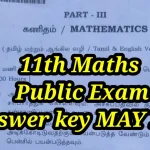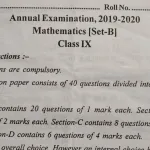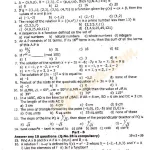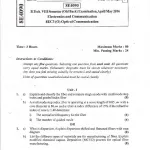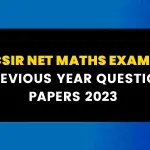What is the value of 12 + 36 ÷ 6 × 2 – 5?
First divide 36 by 6 to get 6. Then multiply by 2 to get 12. Add 12 and 12 to get 24, and subtract 5. Final answer: 19
Solve 8 × (5 + 3) – 6
Add 5 and 3 to get 8. Multiply by 8 to get 64. Subtract 6. Final answer: 58
Calculate 25 – 5 × 2 + 10
Multiply 5 by 2 to get 10. Then subtract from 25 to get 15. Add 10. Final answer: 25
Find the answer to 60 ÷ (10 + 2) + 4
Add 10 and 2 to get 12. Divide 60 by 12 to get 5. Add 4. Final answer: 9
What is the result of 7 + 3 × 4 – 2
Multiply 3 by 4 to get 12. Add 7 to get 19. Subtract 2. Final answer: 17
Evaluate 100 – 4 × (6 + 1)
Add 6 and 1 to get 7. Multiply by 4 to get 28. Subtract from 100. Final answer: 72
Calculate 48 ÷ 4 + 6 × 2
Divide 48 by 4 to get 12. Multiply 6 by 2 to get 12. Add both. Final answer: 24
Solve (9 + 3) × 2 – 5
Add 9 and 3 to get 12. Multiply by 2 to get 24. Subtract 5. Final answer: 19
Find the answer of 5 × 2 + 8 ÷ 2
Multiply 5 by 2 to get 10. Divide 8 by 2 to get 4. Add both. Final answer: 14
What is 90 ÷ (3 + 3 × 2)
First multiply 3 by 2 to get 6. Add 3 to get 9. Divide 90 by 9. Final answer: 10
Evaluate 3 + 6 × (5 + 4) ÷ 3
Add 5 and 4 to get 9. Multiply by 6 to get 54. Divide by 3 to get 18. Add 3. Final answer: 21
Solve 72 ÷ 8 × (2 + 1)
Divide 72 by 8 to get 9. Add 2 and 1 to get 3. Multiply both. Final answer: 27
What is 50 – 10 + 3 × 2
Multiply 3 by 2 to get 6. Subtract 10 from 50 to get 40. Add 6. Final answer: 46
Find result of 8 × (7 – 2) + 10
Subtract 2 from 7 to get 5. Multiply by 8 to get 40. Add 10. Final answer: 50
Calculate 10 + 20 × 2 – 15 ÷ 3
Multiply 20 by 2 to get 40. Divide 15 by 3 to get 5. Add 10 and 40 to get 50. Subtract 5. Final answer: 45
Solve (4 + 4) × (6 – 2)
Add 4 and 4 to get 8. Subtract 2 from 6 to get 4. Multiply both. Final answer: 32
Evaluate 100 – (5 × 4 + 10)
Multiply 5 by 4 to get 20. Add 10 to get 30. Subtract from 100. Final answer: 70
What is 6 + 18 ÷ (3 × 2)
Multiply 3 by 2 to get 6. Divide 18 by 6 to get 3. Add 6. Final answer: 9
Calculate (12 + 8) ÷ 4 × 3
Add 12 and 8 to get 20. Divide by 4 to get 5. Multiply by 3. Final answer: 15
Solve 45 – (6 + 3) × 2
Add 6 and 3 to get 9. Multiply by 2 to get 18. Subtract from 45. Final answer: 27
Find result of 36 ÷ (2 + 4) + 5
Add 2 and 4 to get 6. Divide 36 by 6 to get 6. Add 5. Final answer: 11
What is 50 ÷ 5 × (3 + 1)
Divide 50 by 5 to get 10. Add 3 and 1 to get 4. Multiply both. Final answer: 40
Evaluate (10 + 2) × 3 – 9
Add 10 and 2 to get 12. Multiply by 3 to get 36. Subtract 9. Final answer: 27
Solve 20 + (30 ÷ 5) × 2
Divide 30 by 5 to get 6. Multiply by 2 to get 12. Add 20. Final answer: 32
Find answer to (6 + 2) × (5 – 3)
Add 6 and 2 to get 8. Subtract 3 from 5 to get 2. Multiply both. Final answer: 16
Calculate 60 ÷ 3 + (4 × 5)
Divide 60 by 3 to get 20. Multiply 4 by 5 to get 20. Add both. Final answer: 40
What is (7 × 2 + 4) ÷ 6
Multiply 7 by 2 to get 14. Add 4 to get 18. Divide by 6. Final answer: 3
Evaluate 15 + (5 × 2 – 3)
Multiply 5 by 2 to get 10. Subtract 3 to get 7. Add 15. Final answer: 22
Solve (18 – 6) × (4 + 1)
Subtract 6 from 18 to get 12. Add 4 and 1 to get 5. Multiply both. Final answer: 60
What is 10 + 6 × (3 + 2)
Add 3 and 2 to get 5. Multiply by 6 to get 30. Add 10. Final answer: 40
Find the result of 28 ÷ (4 + 3) + 2
Add 4 and 3 to get 7. Divide 28 by 7 to get 4. Add 2. Final answer: 6
Evaluate (6 × 2) + (8 ÷ 2)
Multiply 6 by 2 to get 12. Divide 8 by 2 to get 4. Add both. Final answer: 16
Solve 5 + 2 × 4 – (6 ÷ 2)
Multiply 2 by 4 to get 8. Divide 6 by 2 to get 3. Add 5 and 8 to get 13. Subtract 3. Final answer: 10
What is (3 + 9) × (8 – 6)
Add 3 and 9 to get 12. Subtract 6 from 8 to get 2. Multiply both. Final answer: 24
Calculate 50 – (12 ÷ 3 + 4)
Divide 12 by 3 to get 4. Add 4 to get 8. Subtract from 50. Final answer: 42
Find the result of (16 + 4) ÷ 5 × 2
Add 16 and 4 to get 20. Divide by 5 to get 4. Multiply by 2. Final answer: 8
Solve 40 ÷ (2 × 2 + 4)
Multiply 2 by 2 to get 4. Add 4 to get 8. Divide 40 by 8. Final answer: 5
What is 36 – 6 × (2 + 4)
Add 2 and 4 to get 6. Multiply by 6 to get 36. Subtract from 36. Final answer: 0
Evaluate (7 + 1) × (6 – 3)
Add 7 and 1 to get 8. Subtract 3 from 6 to get 3. Multiply both. Final answer: 24
Solve 18 + (4 × 5) – 6
Multiply 4 by 5 to get 20. Add 18 to get 38. Subtract 6. Final answer: 32
Find result of 72 ÷ (8 + 4) × 2
Add 8 and 4 to get 12. Divide 72 by 12 to get 6. Multiply by 2. Final answer: 12
What is (5 + 3) × (6 – 1)
Add 5 and 3 to get 8. Subtract 1 from 6 to get 5. Multiply both. Final answer: 40
Evaluate 9 + (18 ÷ 3) × 2
Divide 18 by 3 to get 6. Multiply by 2 to get 12. Add 9. Final answer: 21
Solve 100 ÷ (4 + 6 × 1)
Multiply 6 by 1 to get 6. Add 4 to get 10. Divide 100 by 10. Final answer: 10
Calculate (10 × 2 – 4) + 6
Multiply 10 by 2 to get 20. Subtract 4 to get 16. Add 6. Final answer: 22
Find answer to 8 × (6 – 4) + 3
Subtract 4 from 6 to get 2. Multiply by 8 to get 16. Add 3. Final answer: 19
Solve (12 ÷ 4 + 3) × 2
Divide 12 by 4 to get 3. Add 3 to get 6. Multiply by 2. Final answer: 12
What is (9 + 3) ÷ (6 – 3)
Add 9 and 3 to get 12. Subtract 3 from 6 to get 3. Divide 12 by 3. Final answer: 4
Top Indian Books for Class 7 BODMAS Practice: Authors, Publishers & Content Overview
-
Mathematics Class 7
Author: R.D. Sharma
Publisher: Dhanpat Rai Publications
Content: Comprehensive coverage of Class 7 mathematics topics, including detailed explanations and practice problems on BODMAS.Amazon -
Mathematics for Class 7
Author: R.S. Aggarwal
Publisher: Bharti Bhawan
Content: Extensive exercises on BODMAS and other arithmetic operations, with step-by-step solutions to enhance problem-solving skills. -
NCERT Mathematics Textbook for Class 7
Publisher: NCERT
Content: Standard textbook following the CBSE curriculum, providing foundational knowledge and practice questions on BODMAS and related concepts. -
Composite Mathematics for Class 7
Author: Anubhuti Gangal
Publisher: S. Chand Publishing
Content: Structured lessons with a focus on BODMAS, including illustrative examples and exercises to reinforce understanding. -
Maths Rehearse Practice Book Class 7
Publisher: Macmillan Education
Content: Practice-oriented workbook offering a variety of BODMAS problems, including multiple-choice and real-life application questions.Amazon -
NCERT Mathematics Practice Book for CBSE Class 7
Authors: Anita Sharma, Dr. K.P. Chinda
Publisher: S. Chand School Books
Content: Supplementary practice book aligned with NCERT syllabus, featuring BODMAS exercises with detailed solutions. -
Spiral Maths – Class 7
Authors: P.S. Roy, Pulkit Kumar
Publisher: Geeta Publishing House
Content: Innovative approach to teaching BODMAS through spiral learning, with progressive difficulty levels in exercises. -
CBSE Mathematics Class 7
Author: Laxmi Publications
Publisher: Laxmi Publications
Content: Comprehensive guide covering BODMAS rules with ample practice questions and model test papers. -
Mathematics Today – Class 7
Publisher: S. Chand Publishing
Content: Engaging content with a focus on BODMAS, including puzzles and activities to enhance analytical skills. -
Target Mathematics Class 7
Publisher: Oxford University Press
Content: Curriculum-based textbook offering clear explanations and practice exercises on BODMAS and other mathematical operations. -
New Mathematics Ahead Class 7
Publisher: Orient BlackSwan
Content: Conceptual clarity on BODMAS through interactive lessons and varied problem sets. -
Math Vision Class 7
Publisher: Pearson Education
Content: Focuses on developing a strong foundation in BODMAS with real-life examples and practice exercises. -
Foundation Mathematics for Class 7
Publisher: Goyal Brothers Prakashan
Content: Offers a variety of BODMAS problems to strengthen computational skills and logical reasoning. -
Mathematics Success Book 7
Publisher: Ratna Sagar
Content: Provides comprehensive coverage of BODMAS with step-by-step solutions and practice worksheets. -
Excel in Mathematics Class 7
Publisher: Full Marks Pvt. Ltd.
Content: Includes detailed explanations of BODMAS rules and a wide range of practice questions for mastery. -
Maths Lab Activities Class 7
Publisher: Arya Publications
Content: Hands-on activities and experiments to understand BODMAS concepts effectively. -
Understanding Mathematics Class 7
Publisher: Arya Publications
Content: Emphasizes conceptual understanding of BODMAS with illustrative examples and exercises. -
Mathematics Workbook Class 7
Publisher: Evergreen Publications
Content: Practice workbook with a variety of BODMAS problems to enhance computational proficiency. -
Step by Step Mathematics Class 7
Publisher: Frank Brothers
Content: Sequential approach to learning BODMAS, with graded exercises and assessments. -
Progressive Mathematics Class 7
Publisher: New Saraswati House
Content: Integrates BODMAS concepts with real-life applications and problem-solving strategies.
These books are tailored to help Class 7 students grasp the BODMAS concept effectively through a variety of teaching methods and practice exercises.
BODMAS Questions for Class 7: Strengthen Your Math Skills with Confidence
Understanding BODMAS is a crucial step in building a strong mathematical foundation for Class 7 students. BODMAS stands for Brackets, Orders, Division, Multiplication, Addition, and Subtraction. It tells us the correct order to solve math expressions and helps avoid confusion when multiple operations are involved. At this stage, students are expected to go beyond basic arithmetic and start applying these rules to more complex numerical expressions.
BODMAS questions for Class 7 typically involve problems where two or more operations appear together. For example, a student might see an expression like 12 + 36 ÷ 6 × 2 – 4 and will need to apply the BODMAS rule step by step to get the correct answer. It’s not just about solving problems—it’s about learning how to think logically and process steps in the right order.
One of the best ways for students to grasp the concept is through consistent practice. Teachers and experts recommend mixing simple problems with more challenging ones. Start with expressions involving just addition and subtraction, then gradually include multiplication and division. Once students are comfortable, introduce brackets and powers to deepen their understanding.
Many BODMAS worksheets for Class 7 include both direct numerical expressions and word problems. These worksheets are designed to sharpen analytical thinking. Word problems especially help students connect math to everyday situations. For example, a problem might say: Ravi has 5 baskets with 6 apples each. He gives away 10 apples. How many does he have left? These scenarios require students to apply the BODMAS rule after identifying the operations involved.
Experts suggest encouraging students to write down every step while solving. This helps avoid careless mistakes and reinforces the order of operations. For example, writing out each stage clearly ensures they understand why division comes before addition or why brackets must be solved first.
Interactive activities also play a vital role in mastering BODMAS. Using puzzles, math games, and class competitions can make learning fun. When students work in groups to solve problems, they discuss different approaches, which helps reinforce their understanding.
To support this learning, there are several Class 7 math books that focus on BODMAS. These books provide detailed explanations, solved examples, and a variety of practice questions. Look for books that include mock tests and self-assessment sections. These help track progress and highlight areas that need improvement.
Parents can also help by asking quick mental math questions based on BODMAS during daily activities. For instance, ask questions like What is 8 + 12 ÷ 4? during a car ride or while setting the dinner table. These small exercises help build confidence and speed.
Another expert-backed tip is to combine visual learning with written practice. Use number lines, flow charts, or tree diagrams to explain how operations are prioritized. This makes abstract rules more concrete for visual learners.
With regular practice, the right guidance, and a strong focus on step-by-step solving, students in Class 7 can become confident in solving BODMAS questions. It’s not just about getting the answer—it’s about understanding how numbers interact through the correct sequence of operations.
FAQ for BODMAS Questions for Class 7
What is BODMAS and why is it important in Class 7 math?
BODMAS stands for Brackets, Orders, Division, Multiplication, Addition, and Subtraction. It is a rule that helps students understand the correct sequence to solve mathematical expressions. It prevents confusion when multiple operations are involved in a single problem.
How do Class 7 students apply BODMAS in problem-solving?
Students apply BODMAS by solving operations in a specific order: first brackets, then orders (like squares), followed by division and multiplication, and finally addition and subtraction. Each step must be followed to get accurate results.
What kind of BODMAS questions are included in Class 7 curriculum?
BODMAS questions in Class 7 include numerical expressions, word problems, multi-step calculations, and puzzles that test a student’s logical reasoning and order of operations understanding.
Are brackets always solved first in BODMAS?
Yes, according to the BODMAS rule, brackets must always be solved first. If there are multiple types of brackets, the innermost one is solved first, then you move outward.
Can BODMAS be used in word problems?
Absolutely. Word problems often involve real-life scenarios where students have to identify the operations involved and apply BODMAS to find the correct answer.
Is there a difference between BODMAS and PEMDAS?
BODMAS and PEMDAS are essentially the same. BODMAS is commonly used in India and the UK, while PEMDAS is used in the US. Both stand for the order of operations, with slight differences in terminology.
How can I get better at solving BODMAS questions?
Practice regularly using a mix of simple and complex problems. Work step-by-step, check your work, and try to understand each mistake. Use visual aids, worksheets, and ask questions when you’re unsure.
What are some common mistakes students make while using BODMAS?
Common mistakes include skipping brackets, performing addition before multiplication, or not following the correct sequence. Writing down each step can help avoid these errors.
Are there any tips to remember the BODMAS order easily?
Yes! The acronym itself is a great memory aid. Just remember: Brackets, Orders, Division/Multiplication (from left to right), Addition/Subtraction (from left to right).
Do BODMAS rules apply in algebra as well?
Yes, the BODMAS rule applies to algebraic expressions too. When variables are involved, the order of operations remains the same.
How many types of brackets are used in BODMAS problems?
There are three types: parentheses ( ), curly brackets { }, and square brackets [ ]. Problems may involve one or a combination of these.
Should multiplication be done before division?
Not necessarily. Division and multiplication are done from left to right, in the order they appear. The same rule applies to addition and subtraction.
What should I do if an expression has multiple brackets and operations?
Start with the innermost bracket, solve that first, and then move to the next outer bracket, following the BODMAS sequence in each step.
Can calculators be used for BODMAS questions?
In most school settings, calculators are not allowed. Students are encouraged to practice manually to strengthen their logical and arithmetic skills.
Latest Posts
- Step-by-step guide to download and apply for jee mains admit card 202
- Comprehensive 2025 government holidays and recruitment details for job seekers
- JEE Mains Admit Card 2025: Your Step-by-Step Guide to Downloading the Hall Ticket
- Everything You Need to Know About 2025 Government Holidays Recruitment
- Comprehensive Guide to rrb d group recruitment 2025 – Eligibility, Vacancies, and Application
- Detailed guide to nps trust recruitment 2025 vacancies, eligibility and apply process
- Comprehensive guide to hpcl recruitment 2025 notification, vacancies, and application process
- ignou bed admission 2025 complete recruitment guide with eligibility and process
- Comprehensive Guide to Indian Army Agniveer Recruitment 2025 Notification and Jobs
- Everything You Must Know About CBSE Board Exams 2025 Changes & New Rules


